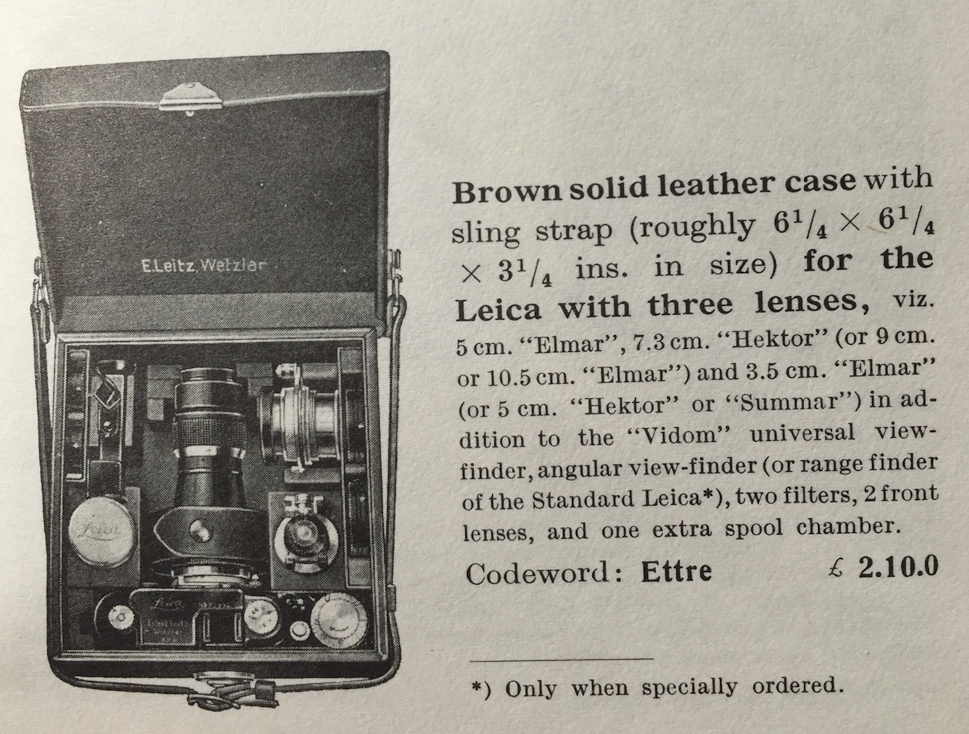
Solid leather fitted camera system cases were immensely popular from the 1920s through to 1960s. They were in their heyday before the second world war and the smart Leica owner of the time is likely to have coveted a compact brown leather hold-all such as this Leica ETTRE with custom fittings for the equipment.
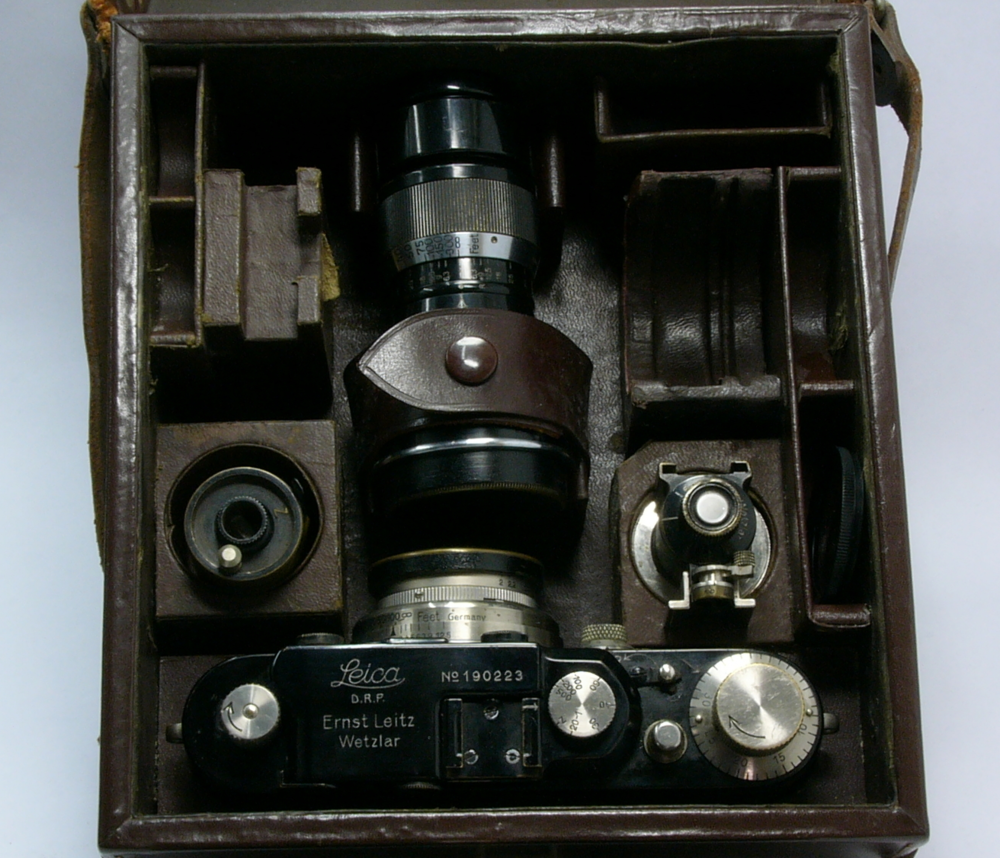
These cases, and similar, were the forerunners of today’s Billinghams and Loewe Pros. However, because they were made to accommodate with precision a specific range of equipment, they were often kept together— as is the case with this 80-year-old set.
Complete kit
We were able to borrow the ETTRE case stuffed with period gear for a short inspection at our Holborn offices. What is particularly unusual about this outfit is that it was purchased complete in 1936 with a black-painted Leica III and all the lenses and accessories you would need for general snapping. It has been in one family for 80 years and, despite a bit of wear and tear, is still as serviceable as when it left the dealer’s counter before the war. Unlike the M3 set which we covered last week, this is not a pristine, as-new collection. Instead it has been well used through its life and is a testimony to the sturdy construction and long life of Leica products of the era.
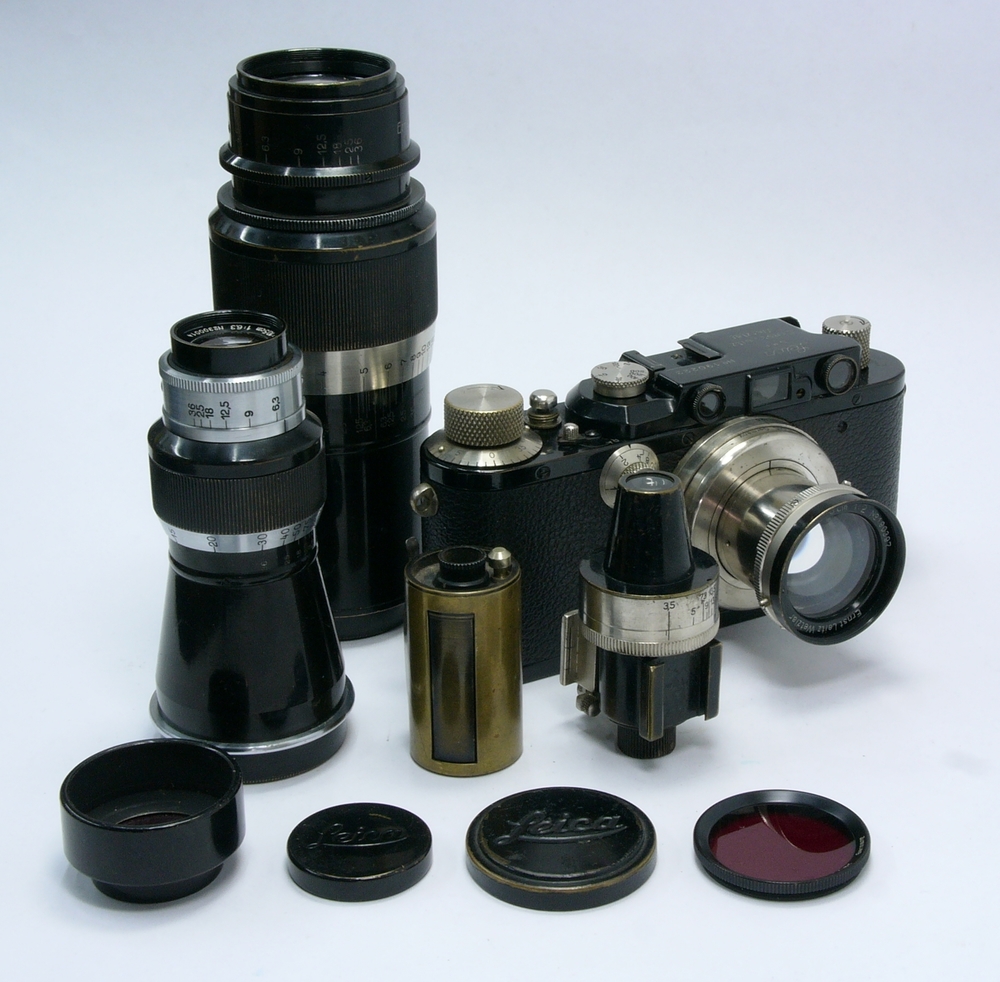
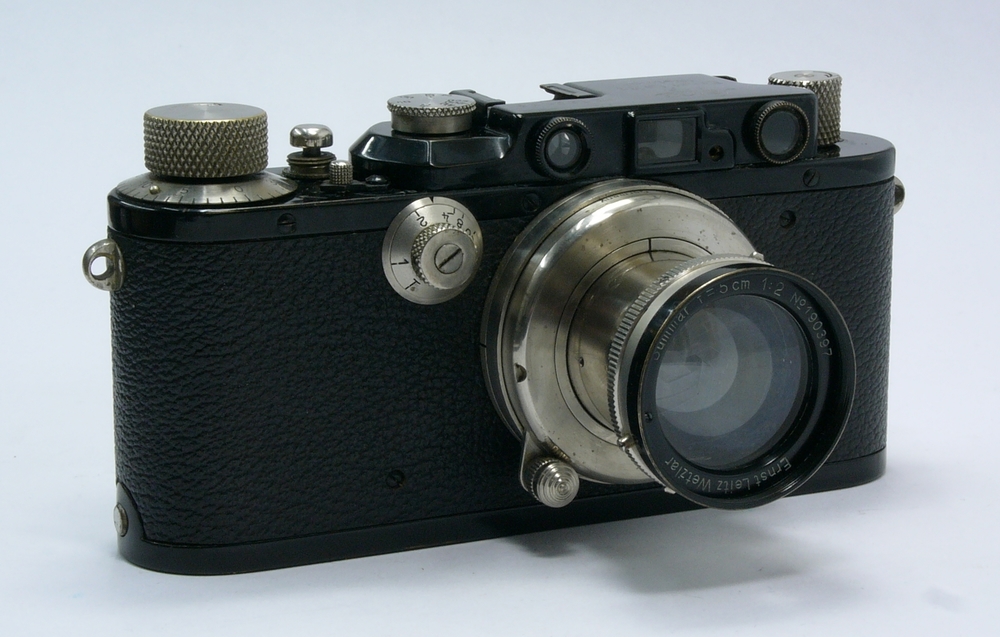
Focal point of this outfit is the very tidy black III. Although the black-paint version was marketed as a cheaper camera than the chrome III, things are now turned on their heads and it is the black version which commands the higher prices according to our LTM¹ expert, William Fagan.
At launch in 1933, he says, the black and nickel III with Summar was £33.13s.0d and the chrome equivalent was £34.17s.0d. One pound four shillings was a lot in those days and could easily influence a buying decision. By 1936, when this kit was purchased, the black camera and Summar lens cost £39.10s.0 compared with £40.16s.0d for the chrome version (see below for precise costings). The camera body, without lens, would have cost £23.2d.0d.
This is a well-preserved III with the nickel knobs and dials in almost perfect condition; normally there is significant scratching and tarnishing of the metal after so many years.
Nickel Summar
But the highlight is the 5cm f/2 Summar in nickel. This is one of the cleanest and most attractive period nickel lenses I have encountered. It is also unusual in that the front rim is painted black. This is quite rare and it is a sought after lens. The extension tube is remarkably unscathed and shiny, with minimal scratching and no evidence of tarnish. Aperture and depth-of-field scales are also gleaming like new. This is a lens through which you can thoroughly appreciate the undoubted lust that it would have attracted in grandfather’s time.
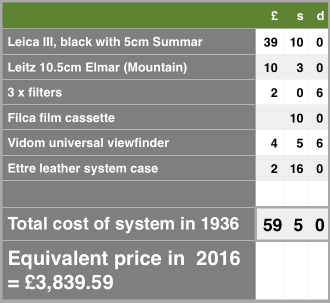
The case holds three original filters with their screw-in tightening bands, made for the Summar and Elmar, a rather tatty but serviceable VIDOM universal finder (with the reverse image, rather disconcerting), a metal reloadable FILCA B film cassette and caps for the lenses. There are two vacant slots, one that should hold a 3.5cm Elmar, preferably in nickel to match the rest of the outfit, and one for the accessory-shoe rangefinder which was probably not supplied at the time of purchase because the III doesn’t need one.
Mountain gem
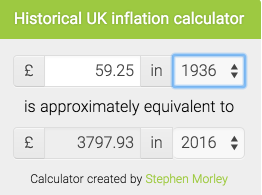
Jewel in this particular case, however, is not the tidy Leica III nor, even, the beautiful nickel Summar. The real gem is sitting in the middle, the 10.5cm Berg Elmar (Mountain or Alpine Elmar), a lens that is now quite rare and which has an interesting history. This is a good example, including tiny lens cap and microscopic hood. Only 3,975 Mountain Elmars were sold between 1932 and 1937, so this is one of the later examples. At the time they were not very popular, possibly because of the slow aperture. Now they are highly desirable and this item, alone, would be worth upwards of £800.
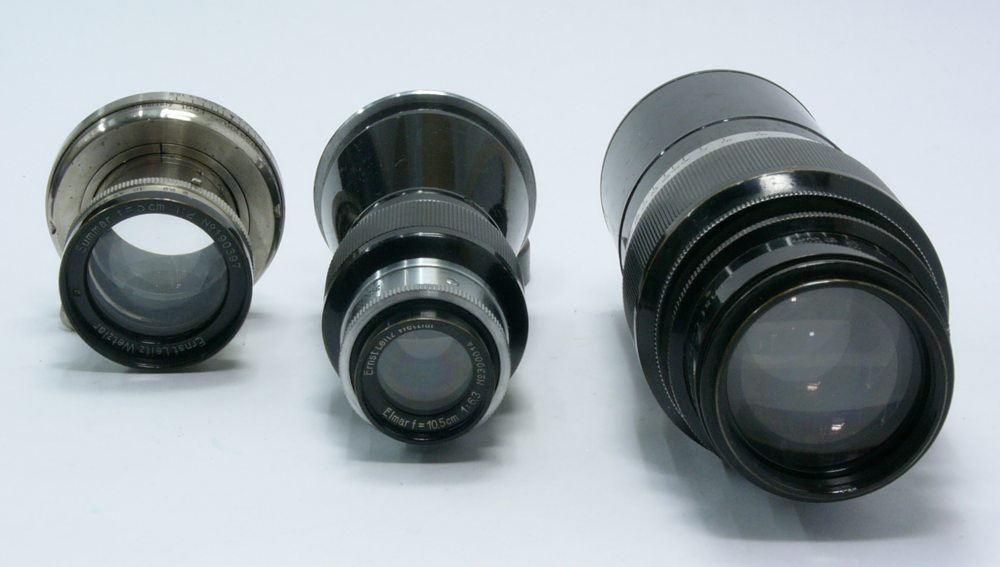
The Mountain Elmar is an ultra-compact and light (240g) medium tele with maximum aperture of f/6.3. It was designed primarily for outdoor activities, such as mountain climbing and hiking, from which the name is derived. Mounted on the III, it makes a very compact combination for landscapes and, of course, for portraiture.
In addition to the box of goodies, the set came with an f/4.5 13.5cm Elmar which is in reasonable but not outstanding condition. Discontinued in 1936 (and superseded by the Hektor), the Elmar is missing from the 1936 catalogue but was listed at £13.14s.0d in 1933.
Desirable
This is an highly desirable complete travel outfit from the early days of Leica. I thoroughly agreed with Ivor Cooper’s reluctance to split the consignment; this is a set that deserves to live together for another 80 years. Sometimes sentiment does come into business.
As for original cost, I happen to have a Leica General Catalogue for 1936 in front of me and have been able to work out the exact cost of this kit. It came to a total of £59.5s.0d, including the camera and two lenses, plus the case and accessories (but excluding the separate Elmar 13.5cm). That come to just under £3,800 in 2016. Indeed, if you were to buy a modern equivalent of the III (a Leica M-A at £3,250), plus equivalent modern lenses and accessories, you would pick up a bill nearer to £6,000.
The brown leather case and fitted equipment was on sale at Red Dot Cameras for £1,499 last week. The camera had been serviced and the lenses cleaned, ready for another 80 years of action. Not surprisingly, it was snapped up within hours of appearing on the site. The new owner was happy for this article to appear.
All photographs with the exception of the leading picture (a scan supplied by William Fagan) were taken by Red Dot Cameras. Thanks to Ash and Francis for their time and skill.
Read how Mike Evans took his own Leica III back to Brooklands to get some atmospheric period shots.
- Subscribe to Macfilos for free updates on articles as they are published. Read more here
- Want to make a comment on this article but having problems? Please read this
________________________
¹ Leica Thread Mount, also known as Leica Screw Mount ↩︎

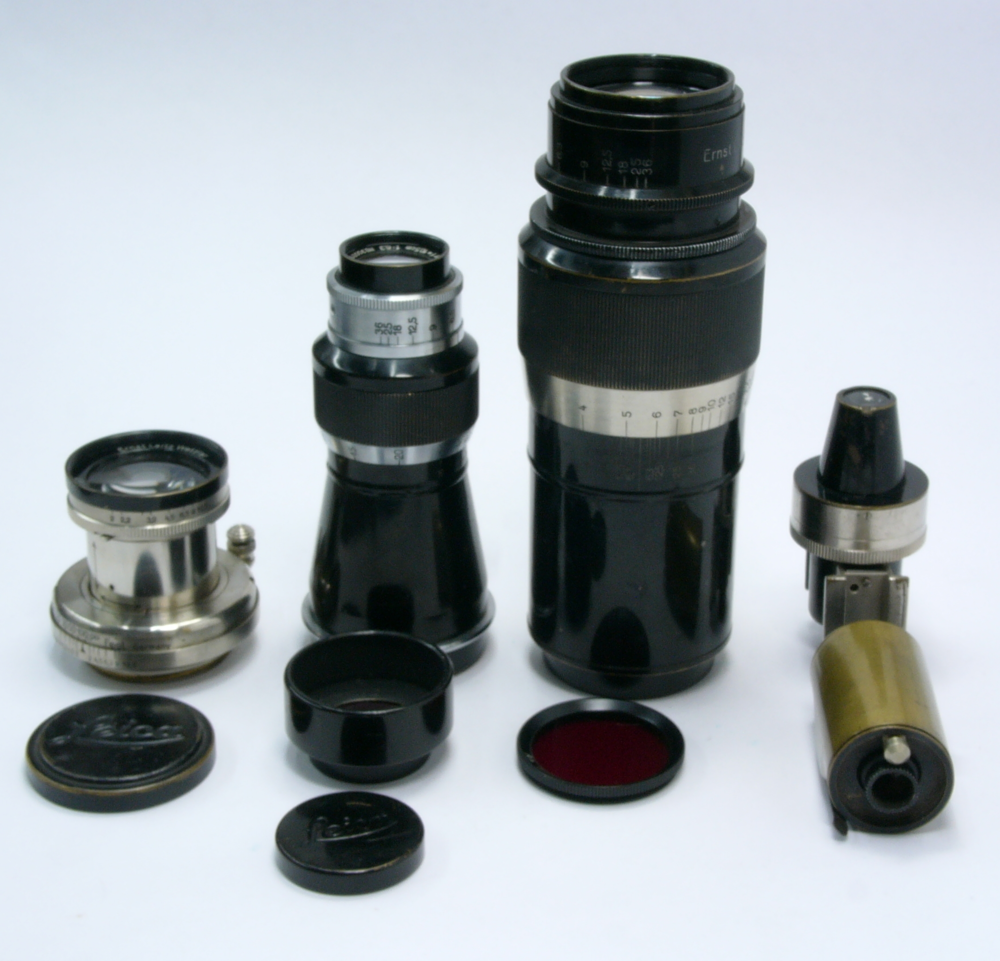
Not so young anymore William in Dublin has the ETGAM case from 1931, which was the first such case produced by Leica. These cases were introduced when Leica introduced interchangeable lenses, firstly on a non standardised (had to be matched individually to the camera) basis and then on a standardised basis with a ‘0’ on both the camera lens mount and the lens. The ETTRE shown here is a later smaller case produced in the mid 1930s. It was, like the ETGAM, small enough to be carried on your shoulder and was thus the very first fore-runner of all those Billinghams and Lowe-Pros you see today. At the time the ETTRE was introduced, Leica introduced some larger cases which were more for carrying all your kit from point to point than for use ‘in the field’. My ETGAM has a tiny key for the front lock which has followed it around for 85 years. The photo above makes the case look quite big but both it and the ETGAM are quite tiny, much smaller than, say, a Billingham Hadley.
Moving on to the contents, I have all of the items here with the exception of the 5cm Summar nickel with black rim and the 13.5 cm Elmar lens ; both of them are worthy of comment. I have seven collapsible Summars of different variants, largely an ‘accidental collection’ as most came attached to cameras which I bought. While I have a nickel model and a chrome one with a black rim I don’t have a nickel one with a black rim. This is one of the rarest of the collapsible Summars and certainly the most valuable; it is on my ‘wants list’. There was an earlier rigid Summar produced in both nickel and chrome, which is even more valuable today because of its rarity. It fetches prices into the thousands (choose your currency). Now for some irony. Leica, as with other products, offered an upgrade programme to convert the rigid lens to collapsible and, according to Jim Lager, many were so converted, thus increasing the rarity and value of the rigid models over 80 years later and, of course, reducing the later value of the converted items. There were several such upgrade programmes and ‘upgraded’ lenses and cameras are nowadays usually worth a lot less than ‘original models’. People who are not collectors often find this hard to understand.The most valuable and rarest Summar is the ‘Tropen’ Summar produced for use in tropical climes. According to the Collectiblend website, the Tropen fetches between $8,000 (average) to $ 18,000 (mint).
Mike and I have had a number of discussions about the 13.5cm. Like the 50mm Elmar, the 13.5cm lens underwent many changes over a very short period of time; even more so than we see in today’s mad upgrade-happy digital world. This was because Leica was making very rapid progress in design concepts, many of which are still to be seen in today’s cameras. Paul Henry van Hasbroeck describes the various changes in his book. The main staging points were non standardised and uncoupled, standardised and uncoupled and, finally, standardised and coupled, which is what you get with today’s M mount lenses. After much discussion, Mike and I have determined that this lens is, probably’ in the middle category, standardised and uncoupled. If I got it into my hands I could probably confirm this for certain. I do intend to add an early 13.5cm black and nickel lens to my collection but it is not a big priority as I am not particularly interested in telephoto lenses.
Finally, for Stephen re FILCAs I have a largely ‘accidental’, but unused, collection of a FILCA A (one ) and a good number of the most common type, FILCA B. I did buy (not accidentally) two copies of the FILCA C, which is one of the rarest of all Leica accessories. When Jim Lager wrote his book on Leica Accessories some years ago, he said that he had never seen one in 20 years of searching. There is also supposed to be a FILCA D but I have never been able to trace one. We had some discussion about this on the Leica Forum and the general conclusion is that the FILCA D is what is known as the Agfa- Leica Cassette and some of these seem to be around. In post war years this later model became the IXMOO, which is suitable for use in M cameras, and this may be what you want, Stephen. See the advice from TomB from Texas on the links below. Somewhere, deep in the heart of Texas, there is a very knowledgeable guy using the old reloadable cassettes. He is extremely generous with his knowledge and it might be worthwhile getting in touch with him.
http://www.l-camera-forum.com/topic/255938-filca-a-b-and-c-wheres-d/
http://www.l-camera-forum.com/topic/258192-filca-the-descent-continues/
As for me, I use modern non re-usable film cassettes when shooting with old cameras. I may like vintage cameras but I live in the present and drive out to my photo shoots in a modern non vintage Audi car and then later have my photos taken with old cameras scanned to disk. I do, however, admire people like Tom from Texas who go the whole nine yards.
That’s about it.
William
Many thanks for that information William, not sure that I am going to try bulk film loading any time soon, it was just seeing it included in the kit bag that is the subject of this post that made me curious…
I am just about to read your two reference URL’s though William.
Speaking of Tom from Texas, have you seen this gentleman from New York state?
http://theonlinephotographer.typepad.com/the_online_photographer/2016/03/camp-tinype.html
http://www.johncoffer.com
Oh and speaking of film, last week there was an item published by Bellamy at "Japan Camera Hunter" (JCH), about a personal project of his to market his own JCH film…
http://www.japancamerahunter.com/2016/03/film-news-announcing-jch-streetpan-400-film/
Impulsively (perhaps) I jumped in and I suppose that in the fullness of time will be receiving my ten rolls. If anyone is interested, I might well be up for swapping a roll or two.
You are not a collector Mike… 😉
On another note, can anyone tell me how practical it is to use the "Filca" system? Does bulk film feed out nicely from the pack, or does it spring out uncontrollably as tends to happen with an exposed film when loading onto a development spool?
Can bulk film be loaded in several goes… i.e. can one have fewer Filcas than is needed to use a whole roll?
Can bulk film be loaded in a "changing bag"?
I am not necessarily going to do this, but I would be interested to read knowledgable comments!
No I am not! You will notice that this particular piece of collectability was NOT purchased by me. I have my limits. As for film loading, I would’t know my FILCA from my elbow so I will pass this one over to young William in Dublin. He will know.